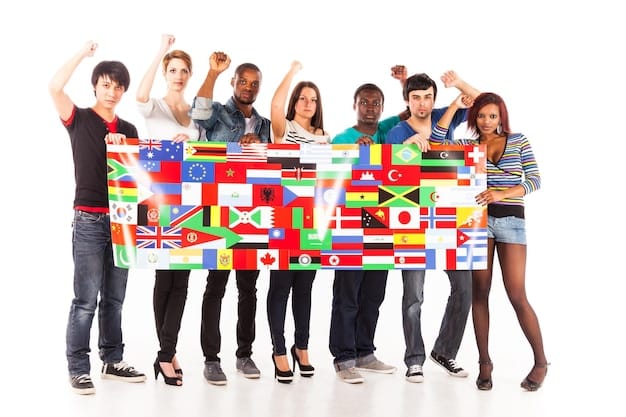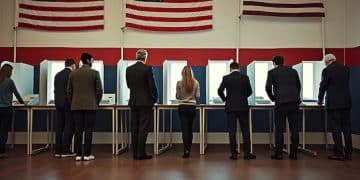US Cultural Exchange Programs: Boosting Diplomacy in 2025

In 2025, the U.S. leverages cultural exchange programs to strengthen diplomatic relations by fostering mutual understanding, promoting American values, and building lasting connections through education, arts, and professional development initiatives.
How is the U.S. strategically employing cultural exchange programs to enhance its diplomatic relations in 2025? These programs, designed to foster international understanding and collaboration, are a key component of U.S. foreign policy. The focus in 2025 is on leveraging these initiatives to build stronger, more resilient relationships with countries around the globe. This article delves into the specific ways the U.S. is achieving this goal.
The Role of Cultural Exchange in Modern Diplomacy
Cultural exchange programs have long been recognized as a valuable tool in diplomacy. They serve as a bridge between nations, fostering mutual understanding and respect. In 2025, the U.S. is intensifying its efforts to utilize these programs to navigate complex international relations and promote its values.
These initiatives provide opportunities for people from different countries to interact, learn from each other, and build lasting relationships. By engaging in cultural exchange, participants gain firsthand experience of other cultures, challenging stereotypes and promoting empathy.

Building Bridges Through People-to-People Diplomacy
People-to-people diplomacy is at the heart of cultural exchange. These programs facilitate direct interaction between individuals, fostering genuine connections that transcend political boundaries.
The U.S. government supports a wide range of programs that bring foreign students, scholars, artists, and professionals to the U.S., and send Americans abroad. These exchanges promote cross-cultural understanding, build networks, and create goodwill.
- Educational Exchanges: Promoting academic collaboration and student mobility.
- Professional Exchanges: Facilitating knowledge sharing and skill development in various fields.
- Arts and Culture Exchanges: Showcasing the diversity of American culture and fostering creative dialogue.
Through these programs, participants not only learn about each other’s cultures but also develop a deeper appreciation for the values and principles that underpin U.S. foreign policy. This helps to create a more favorable environment for diplomatic engagement and cooperation.
In conclusion, cultural exchange plays a vital role in modern diplomacy by fostering understanding, building relationships, and promoting shared values. The U.S. recognizes the importance of these programs and is committed to utilizing them to enhance its diplomatic efforts in 2025 and beyond.
Enhancing Understanding Through Educational Initiatives
Educational initiatives form a cornerstone of U.S. cultural exchange programs. By providing opportunities for foreign students and scholars to study in the U.S., these programs foster a deeper understanding of American society, culture, and values. These experiences can shape perceptions and create lasting connections.
The U.S. also sends American students and scholars abroad, allowing them to immerse themselves in different cultures and gain a global perspective. This bidirectional exchange fosters mutual understanding and promotes international collaboration.
The Fulbright Program: A Flagship Initiative
The Fulbright Program is one of the most prestigious and impactful cultural exchange programs sponsored by the U.S. government. It provides grants for students, scholars, teachers, and professionals to study, teach, or conduct research in other countries.
Established in 1946, the Fulbright Program has fostered intellectual and cultural exchange between the U.S. and more than 160 countries. It has produced numerous leaders in various fields, many of whom have gone on to play significant roles in their respective societies.

- Promoting Academic Excellence: Supporting high-achieving students and scholars.
- Fostering Cross-Cultural Dialogue: Encouraging interaction and understanding between cultures.
- Building Global Networks: Connecting individuals from diverse backgrounds and fields.
In 2025, the Fulbright Program continues to be a vital tool in U.S. diplomacy, promoting mutual understanding and building lasting relationships with countries around the world. Its emphasis on academic excellence and cross-cultural dialogue fosters a more peaceful and prosperous world.
In conclusion, educational initiatives, particularly programs like the Fulbright Program, are essential for enhancing understanding and promoting collaboration through cultural exchange. These programs provide invaluable opportunities for individuals to learn from each other and build bridges between nations.
Promoting American Values and Culture Globally
Cultural exchange programs are not only about understanding other cultures but also about sharing American values and culture with the world. By showcasing the diversity and vibrancy of American society, these programs help to promote a positive image of the U.S. and its people. This can foster goodwill and strengthen diplomatic ties.
The U.S. government supports a wide range of initiatives that promote American values, including democracy, freedom of expression, and respect for human rights. These programs are designed to engage foreign audiences and encourage them to learn more about American society and culture.
Showcasing American Arts and Culture
American arts and culture play a significant role in cultural exchange programs. By showcasing American music, film, literature, and visual arts, these programs provide a window into American society and its values.
The U.S. government supports various initiatives that promote American arts and culture abroad, including cultural diplomacy programs, artist residencies, and international film festivals. These programs help to foster cross-cultural dialogue and promote a positive image of the U.S.
- Music Diplomacy: Using music to bridge cultural divides and promote understanding.
- Film Festivals: Showcasing American films and fostering dialogue about social and political issues.
- Literature Programs: Promoting American literature and encouraging translation into other languages.
These initiatives demonstrate the diversity and creativity of American culture, while also providing opportunities for foreign audiences to engage with American values. This can help to dispel stereotypes and build stronger relationships between the U.S. and other countries.
In conclusion, cultural exchange programs are an effective way to promote American values and culture globally. By showcasing the diversity and vibrancy of American society, these programs help to foster goodwill and strengthen diplomatic ties. The emphasis on arts and culture provides a unique and engaging way to connect with foreign audiences.
Leveraging Technology in Cultural Exchange
In 2025, technology plays a crucial role in enhancing the reach and impact of cultural exchange programs. From virtual exchange programs to online learning platforms, technology enables greater access and participation, regardless of geographical boundaries. This is particularly important in reaching underserved communities and promoting inclusivity.
The U.S. government is investing in technology infrastructure to support cultural exchange programs. This includes developing online platforms for virtual exchange, providing digital resources for language learning, and facilitating virtual access to American cultural institutions.
Virtual Exchange Programs: Connecting Across Borders
Virtual exchange programs are becoming increasingly popular as a cost-effective and accessible way to promote cross-cultural understanding. These programs use online platforms to connect students, teachers, and professionals from different countries, enabling them to engage in collaborative projects and discussions.
Virtual exchange programs can take many forms, including online courses, video conferences, and virtual reality experiences. They provide participants with opportunities to interact with people from different cultures, learn about their perspectives, and build lasting relationships.
- Enhanced Accessibility: Providing opportunities for individuals who may not be able to travel abroad.
- Cost-Effectiveness: Reducing the financial burden of international exchange.
- Scalability: Reaching a larger audience and expanding the impact of cultural exchange.
By leveraging technology, cultural exchange programs can reach a wider audience and have a greater impact on international relations. The emphasis on virtual exchange promotes inclusivity and ensures that everyone has the opportunity to participate in cross-cultural dialogue.
In summary, technology is transforming cultural exchange programs, making them more accessible, cost-effective, and scalable. Virtual exchange programs, in particular, are proving to be a valuable tool for connecting people across borders and promoting mutual understanding.
Measuring the Impact of Cultural Exchange Programs
Assessing the effectiveness of cultural exchange programs is essential for ensuring that they are achieving their intended goals. In 2025, the U.S. government is placing greater emphasis on measuring the impact of these programs and using data to inform future strategies. This involves tracking participant outcomes, evaluating program effectiveness, and identifying areas for improvement.
Various methods are used to measure the impact of cultural exchange programs, including surveys, interviews, and case studies. These assessments provide valuable insights into the ways in which these programs are influencing participants’ attitudes, knowledge, and behaviors.
Key Metrics for Evaluating Program Success
Several key metrics are used to evaluate the success of cultural exchange programs. These include the number of participants reached, the level of cross-cultural understanding achieved, and the impact on diplomatic relations. These metrics provide a comprehensive picture of the program’s effectiveness.
The U.S. government collects data on these metrics through various sources, including program evaluations, participant feedback, and diplomatic reporting. This data is analyzed to identify trends, assess outcomes, and inform future program design.
- Participant Satisfaction: Gauging participants’ overall experience and satisfaction with the program.
- Knowledge and Skills: Assessing changes in participants’ knowledge, skills, and attitudes.
- Diplomatic Impact: Evaluating the program’s contribution to strengthening diplomatic relations.
By measuring the impact of cultural exchange programs, the U.S. government can ensure that these initiatives are achieving their intended goals and contributing to a more peaceful and prosperous world. The emphasis on data-driven decision-making promotes accountability and ensures that resources are used effectively.
In conclusion, measuring the impact of cultural exchange programs is crucial for ensuring their effectiveness and maximizing their contribution to diplomatic relations. By tracking key metrics and using data to inform future strategies, the U.S. government can ensure that these programs are achieving their intended goals.
Future Trends in US Cultural Diplomacy
Looking ahead, U.S. cultural diplomacy is poised to adapt to emerging trends and challenges. In 2025, there is a growing emphasis on inclusivity, diversity, and sustainability. These values are being integrated into cultural exchange programs to ensure that they are relevant and impactful in a rapidly changing world.
The U.S. government is investing in new initiatives that promote these values, including programs that support underrepresented communities, address climate change, and foster sustainable development. These programs are designed to align cultural diplomacy with broader U.S. foreign policy goals.
Promoting Inclusivity and Diversity
Inclusivity and diversity are becoming increasingly important in cultural exchange programs. The U.S. government is committed to ensuring that these programs are accessible to people from all backgrounds, regardless of their race, ethnicity, gender, or socioeconomic status.
Various initiatives are being implemented to promote inclusivity and diversity, including scholarships for underrepresented students, outreach programs for underserved communities, and recruitment efforts to attract a diverse pool of participants.
- Scholarship Programs: Providing financial assistance to students from low-income backgrounds.
- Outreach Initiatives: Engaging with underserved communities and promoting awareness of cultural exchange opportunities.
- Diversity Training: Equipping participants with the skills and knowledge to navigate cross-cultural interactions.
By promoting inclusivity and diversity, cultural exchange programs can better reflect the richness and complexity of American society. This can help to foster greater understanding and empathy between cultures, and strengthen diplomatic ties.
In conclusion, the future of U.S. cultural diplomacy is focused on adapting to emerging trends and challenges, with a strong emphasis on inclusivity, diversity, and sustainability. By integrating these values into cultural exchange programs, the U.S. can ensure that they remain relevant and impactful in a rapidly changing world.
| Key Point | Brief Description |
|---|---|
| 🤝 People-to-People Diplomacy | Fosters understanding through direct interaction between individuals across nations. |
| 🌍 Educational Initiatives | Enhances understanding through programs like Fulbright, promoting academic collaboration. |
| 🎭 American Values & Culture | Promotes a positive image of the U.S. through showcasing arts, music, and democracy. |
| 💻 Technology & Virtual Exchange | Increases accessibility and reach through virtual programs and online learning platforms. |
Frequently Asked Questions (FAQ)
▼
U.S. cultural exchange programs are initiatives designed to promote mutual understanding and build relationships between the United States and other countries through educational, cultural, and professional exchanges.
▼
By fostering people-to-people connections, cultural exchange programs create goodwill and understanding, which can lead to stronger diplomatic ties and cooperation on global issues.
▼
These programs encompass a variety of exchanges, including academic studies, artistic performances, professional training, and youth leadership development, catering to different interests and fields.
▼
Participants vary widely, including students, scholars, artists, teachers, and professionals from diverse backgrounds across the globe, fostering a rich and inclusive exchange environment.
▼
Technology facilitates virtual exchanges, online learning, and broader access to cultural resources, enabling more individuals to participate and connect across geographical boundaries in these programs.
Conclusion
In conclusion, the U.S. is strategically utilizing cultural exchange programs in 2025 to enhance diplomatic relations by fostering mutual understanding, promoting American values, and building lasting connections through various initiatives. These programs play a vital role in shaping a more interconnected and cooperative global community.





